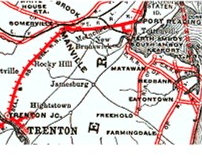The Lehigh Valley Railroad was a railroad in the Northeastern United States built predominantly to haul anthracite coal from the Coal Region in Northeastern Pennsylvania to major consumer markets in Philadelphia, New York City, and elsewhere.

The Reading Company was a Philadelphia-headquartered railroad that provided passenger and freight transport in eastern Pennsylvania and neighboring states from 1924 until its acquisition by Conrail in 1976.

NJ Transit Rail Operations is the rail division of NJ Transit. It operates commuter rail service in New Jersey, with most service centered on transportation to and from New York City, Hoboken, and Newark. NJ Transit also operates rail service in Orange and Rockland counties in New York under contract to Metro-North Railroad. The commuter rail lines saw 57,179,000 riders in 2023, making it the third-busiest commuter railroad in North America and the longest commuter rail system in North America by route length.
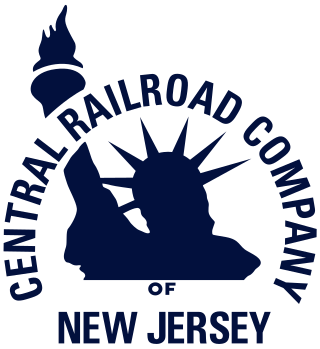
The Central Railroad of New Jersey, also known as the Jersey Central, Jersey Central Lines or New Jersey Central, was a Class I railroad with origins in the 1830s. It was absorbed into Conrail in April 1976 along with several other prominent bankrupt railroads of the Northeastern United States.
Conrail Shared Assets Operations (CSAO) is the commonly used name for modern-day Conrail, an American railroad company. It operates three networks, the North Jersey, South Jersey/Philadelphia, and Detroit Shared Assets Areas, where it serves as a contract local carrier and switching company for its owners, CSX Transportation and the Norfolk Southern Railway. When most of the former Conrail's track was split between these two railroads, the three shared assets areas were kept separate to avoid giving one railroad an advantage in those areas. The company operates using its own employees and infrastructure but owns no equipment outside MOW equipment.

Conrail, formally the Consolidated Rail Corporation, was the primary Class I railroad in the Northeastern United States between 1976 and 1999. The trade name Conrail is a portmanteau based on the company's legal name. It continues to do business as an asset management and network services provider in three Shared Assets Areas that were excluded from the division of its operations during its acquisition by CSX Corporation and the Norfolk Southern Railway.
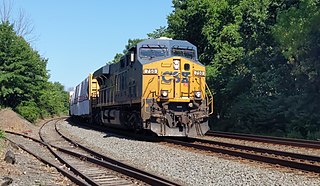
The Conrail Lehigh Line is a railroad line in New Jersey that is part of Conrail Shared Assets Operations under the North Jersey Shared Assets Area division. The line runs from CP Port Reading Junction in Manville to Oak Island Yard in Newark. The line is double-track and signaled through its entire length. The line began operations in 1999 using former existing tracks from Manville to Newark that was once part of the original Lehigh Line which is still in existence and is owned and operated by Norfolk Southern Railway.
North Pennsylvania Railroad was a railroad company which served Philadelphia, Montgomery County, Bucks County and Northampton County in Pennsylvania. It was formed in 1852, and began operation in 1855. The Philadelphia and Reading Railway, predecessor to the Reading Company, leased the North Pennsylvania in 1879. Its tracks were transferred to Conrail and the Southeastern Pennsylvania Transportation Authority (SEPTA) in 1976.

The Trenton Subdivision is a railroad line owned by CSX Transportation in the U.S. states of Pennsylvania and New Jersey. The line runs from CP NICE in Philadelphia, Pennsylvania, northeast to Port Reading Junction in Manville, New Jersey. The line was formerly part of the Reading Company system.

The Harrisburg Line is a rail line owned and operated by the Norfolk Southern Railway (NS) in the U.S. state of Pennsylvania. The line runs from Philadelphia west to Harrisburg.

The Upper Bay Bridge, or the Lehigh Valley Railroad Bridge, is a vertical lift bridge spanning the Newark Bay in northeastern New Jersey. It is used by CSX Transportation travelling through the North Jersey Shared Assets Area of the United States rail network along the National Docks Secondary line. The bridge is just north and parallel to the New Jersey Turnpike's Newark Bay Bridge. A notable train using the bridge is the Juice Train, which originates in Florida.
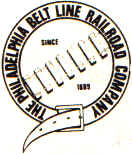
The Philadelphia Belt Line Railroad owns a 2.66-mile (4.28 km) long railroad line running along the Delaware River waterfront in Philadelphia, Pennsylvania. It was created in 1889 to allow any Philadelphia railroad to access the waterfront. The railroad, which does not operate any trains itself, is currently maintained by Conrail Shared Assets Operations and used by CSX Transportation and Norfolk Southern Railway.

Oak Island Yard is a freight rail yard located north of Port Newark-Elizabeth Marine Terminal and Newark International Airport in an industrial area of Ironbound, Newark, New Jersey at 91 Bay Ave., United States. The sprawling complex includes engine house, classification yard, auto unloading terminal, and maintenance facilities. It has ten reception tracks, an automated hump, 30 relatively short classification tracks, and nine departure tracks. In 1999, it classified 800 to 1000 cars per day.
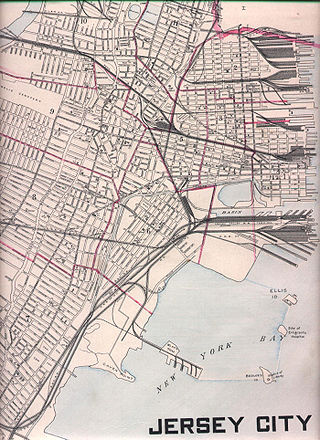
National Docks Secondary is a freight rail line within Conrail's North Jersey Shared Assets Area in Hudson County, New Jersey, used by CSX Transportation. It provides access for the national rail network to maritime, industrial, and distribution facilities at Port Jersey, the Military Ocean Terminal at Bayonne (MOTBY), and Constable Hook as well as carfloat operations at Greenville Yard. The line is an important component in the planned expansion of facilities in the Port of New York and New Jersey. The single track right of way comprises rail beds, viaducts, bridges, and tunnels originally developed at the end of the 19th century by competing railroads.

The Lehigh Line is a railroad line in Central New Jersey, Northeastern Pennsylvania, and the Lehigh Valley region of eastern Pennsylvania. It is owned and operated by the Norfolk Southern Railway. The line runs west from the vicinity of the Port of New York and New Jersey in Manville, New Jersey via Conrail's Lehigh Line to the southern end of Wyoming Valley's Coal Region in Lehigh Township, Pennsylvania.

The Freehold Secondary is an active rail line in New Jersey, the tracks of which are owned by Conrail Shared Assets Operations (CSAO) and operated by the Delaware and Raritan River Railroad (DRR), a subsidiary of Chesapeake and Delaware, LLC. The active portion operates between Jamesburg and Lakewood, New Jersey. The section between Freehold and the junction with the Southern Secondary in Farmingdale had been dormant since 1999; DRR began track rehabilitation on this section on January 16, 2023. On October 13, 2023, the 5–mile Farmingdale–Freehold segment was officially reactivated. In total, 25,000+ feet of rail, 12,500 ties and seven level crossings were replaced in a project that concluded nine months ahead of schedule and under budget. This project makes the operation more efficient, as one train can now serve on-line customers between Browns Yard in Old Bridge, where the train originates, to the line's largest and southernmost customer in Lakewood. DRR intends to grow business with future plans to reactivate dormant track south of Lakewood.
Port Reading Junction is a major rail junction (MANS) in Manville, New Jersey serving rail freight travelling between the Port of New York and New Jersey in Gateway Region of western New Jersey and points to the south and west. It is the site of Manville Yard.
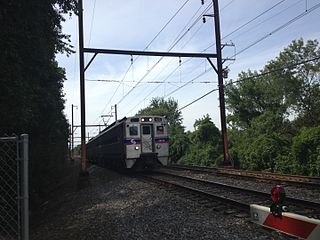
The Neshaminy Line is a railway line in the states of Pennsylvania and New Jersey. It runs 21.7 miles (34.9 km) from a junction with the SEPTA Main Line just north of Jenkintown–Wyncote to West Trenton, just across the Delaware River. It was originally built in 1876 as part of the much longer New York Branch, which continued north to Bound Brook, New Jersey. The electrified section between Jenkin and West Trenton was designated the Neshaminy Line and is now owned by SEPTA. It hosts the West Trenton Line commuter rail service. The freight-only Trenton Subdivision runs parallel between Neshaminy Falls and West Trenton.
The New York Short Line was a railway line in Pennsylvania. It was operated by the Reading Company and built by the New York Short Line Railroad, a subsidiary. It was opened in 1906 to provide a more direct route between Philadelphia and New York City, bypassing the existing route via Jenkintown. The line was conveyed to Conrail in 1976 and is now part of the Trenton Subdivision of CSX.
The Port Reading Secondary, also known as the Port Reading Branch, is a railway line in New Jersey. It runs 16.0 miles (25.7 km) from a junction with the Lehigh Line in Bound Brook, New Jersey, to Port Reading, New Jersey, on the Arthur Kill. Originally built by the Port Reading Railroad and part of the Reading Company system, today the line belongs to Conrail Shared Assets Operations (CSAO).

